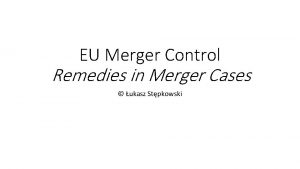EU MERGER CONTROL A CASE STUDY ukasz Stpkowski


- Slides: 2

EU MERGER CONTROL A CASE STUDY © Łukasz Stępkowski, advocate/sworn translator/Ph. D candidate/teaching fellow @ Chair of Int’l and EU law, University of Wrocław

• Undertaking A and Undertaking B conclude an agreement setting up a joint Steering Committee on strategic and tactical issues, aimed at taking decisions for the two undertakings in all matters related to their day-to-day business activities; this Committee is entered into constitutional documents for A and B (e. g. into company statutes) and its members become board members for A and B remain legally separate; they share commercial risks. A is a public limited company established in Kiel, Germany (Aktiengesellschaft) while B is a public limited company established in Wrocław, Poland (spółka akcyjna). A and B are not active on the same market; in fact, A is a producer of screws and B is a tourist bureau, selling affordable holiday packages. • A and B’s combined worldwide turnover for financial year 2016 is 2935000001, 174 USD. A and B are active in all Member States of the Union. In particular, A and B made a turnover of 120 million EUR in Belarus (EUR 24 million), Cyprus (26 million), France (32 million) and Sweden (38 million). • A has a turnover of EUR 251 milion within the Union for the fiscal year 2016, including a sum of EUR 11 million with Z, a company acting as an internal R&D unit of A and wholly owned by it. B has a similar turnover of EUR 251 milion within the Union, including 1 million as a part of a holding with company Y, with which it was a two-part undertaking; this holding was divided for the purposes of setting a joint Committee with A. • Is there a concentration to which EU Merger Regulation is applicable?



